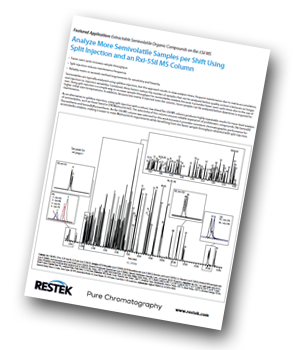Restek has produced an application note describing a split injection method providing a simple way to increase sample throughput for semivolatiles analysis.
 Introduction
Introduction
Semivolatiles are typically analysed using splitless injection, but this approach results in slow analysis times, frequent maintenance due to matrix accumulation, and injection-to-injection variability. Combined, these factors reduce the number of samples that can be analysed before quality control criteria are no longer met. Using split injection is a simple way to increase sample throughput for semivolatiles analysis because it provides faster oven cycle times due to the use of higher initial oven temperatures. In addition, because less matrix is injected onto the column, more samples can be analysed before downtime is required for maintenance.
As an alternative to splitless injection, using split injection with a robust, low-bleed Rxi-5Sil MS column produces highly repeatable results for trace-level analysis of semivolatiles, such as those listed in EPA Method 8270D.
Why use the Rxi-5Sil MS column?
The selectivity of this column ensures reliable separation of problematic compounds, such as benzo[b] fluoranthene and benzo[k]fluoranthene. An Rxi-5Sil MS column was selected for this work because it provides consistent chromatographic performance for semivolatiles analysis, making it easier to meet Method 8270 requirements while benefiting from the faster sample throughput obtained with split injection.
By downloading this application note you will learn how:
- faster oven cycle increases sample throughput
- split injection reduces maintenance frequency
- to reliably meet or exceed method requirements for sensitivity and linearity.




